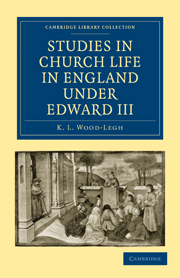Book contents
- Frontmatter
- General Preface
- Introduction
- Contents
- CHAPTER I Royal Administration of Religious Houses
- CHAPTER II Royal Visitations of Hospitals and Free Chapels
- CHAPTER III Alienations in Mortmain
- CHAPTER IV Chantries
- CHAPTER V Appropriation of Parish Churches
- CHAPTER VI Conclusion
- Appendix
- Bibliography
- Index
CHAPTER V - Appropriation of Parish Churches
Published online by Cambridge University Press: 07 September 2010
- Frontmatter
- General Preface
- Introduction
- Contents
- CHAPTER I Royal Administration of Religious Houses
- CHAPTER II Royal Visitations of Hospitals and Free Chapels
- CHAPTER III Alienations in Mortmain
- CHAPTER IV Chantries
- CHAPTER V Appropriation of Parish Churches
- CHAPTER VI Conclusion
- Appendix
- Bibliography
- Index
Summary
One further subject with which the Statute of Mortmain is concerned remains to be considered. This is the appropriation of parish churches. For since in England, advowsons were regarded as temporal property within the cognizance of the lay courts, the Statute of Mortmain was as much concerned with the church's acquisition of advowsons and tithes as of land or rent. No ecclesiastical body, therefore, could legally acquire an advowson unless a licence for the alienation in mortmain had been obtained. Moreover, when a church was appropriated and a monastery or other corporation became its rector, it would not again become vacant, and the king would thus lose the right of presenting to the rectory, which otherwise would have been his, whenever the church fell void while the advowson was in his hands; consequently, even when the would-be appropriators already held the patronage of a church, they could not convert its revenues to their own uses without obtaining letters patent sanctioning the appropriation.
Those who attempted to appropriate a church without royal licence ran the risk of losing its revenues altogether, for the punishment for this offence was forfeiture of the advowson; and if this law was enforced and the king's presentee was admitted to the rectory, the appropriation was, of course, dissolved. In practice, offenders of this kind were often pardoned and allowed to retain their churches, but to procure such a pardon probably involved greater difficulties and expenses than would have been needed to obtain the neglected licence. In these circumstances, the first step taken towards the appropriation of a church was commonly the procuring of a royal licence.
- Type
- Chapter
- Information
- Studies in Church Life in England under Edward III , pp. 127 - 153Publisher: Cambridge University PressPrint publication year: 2010First published in: 1934

